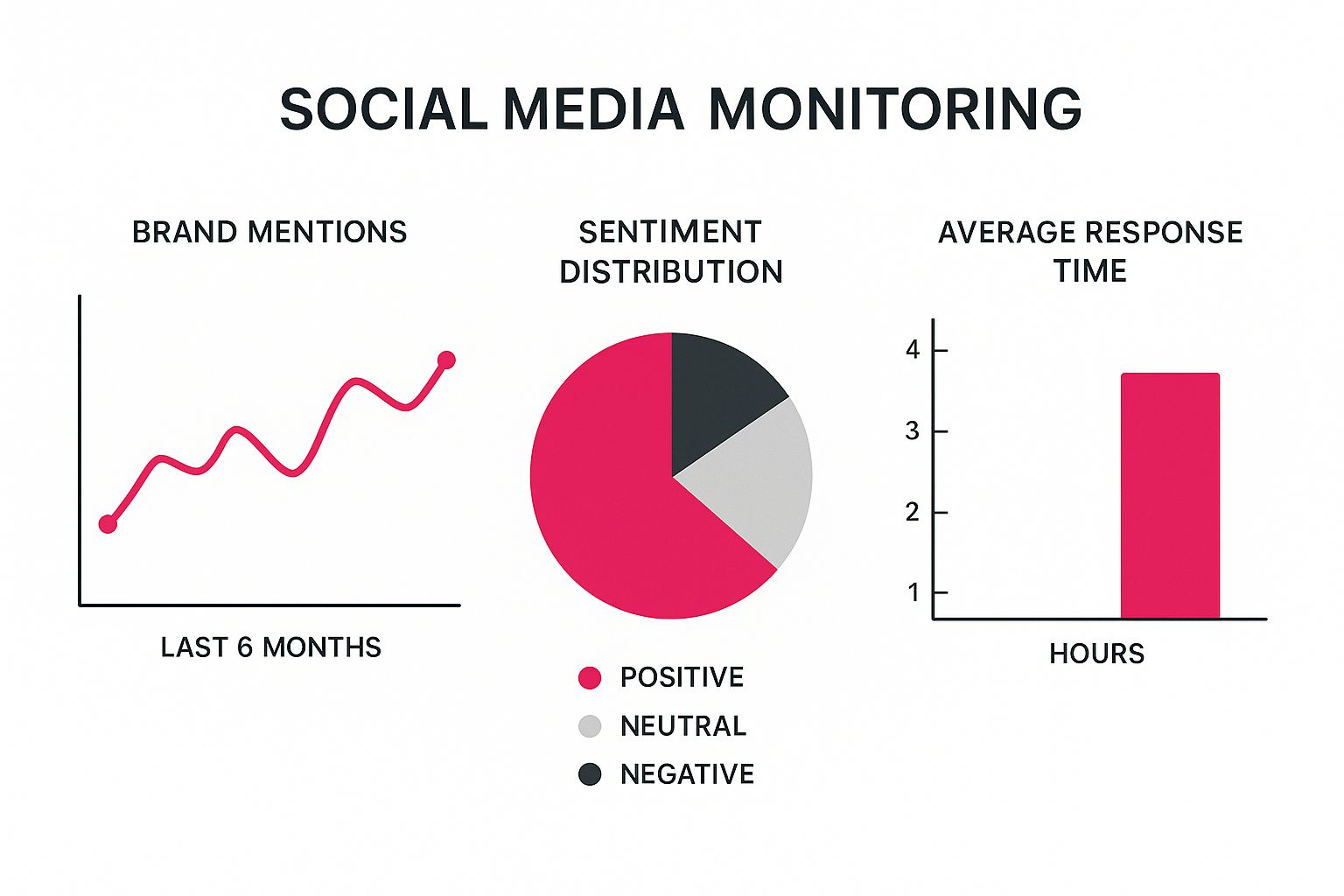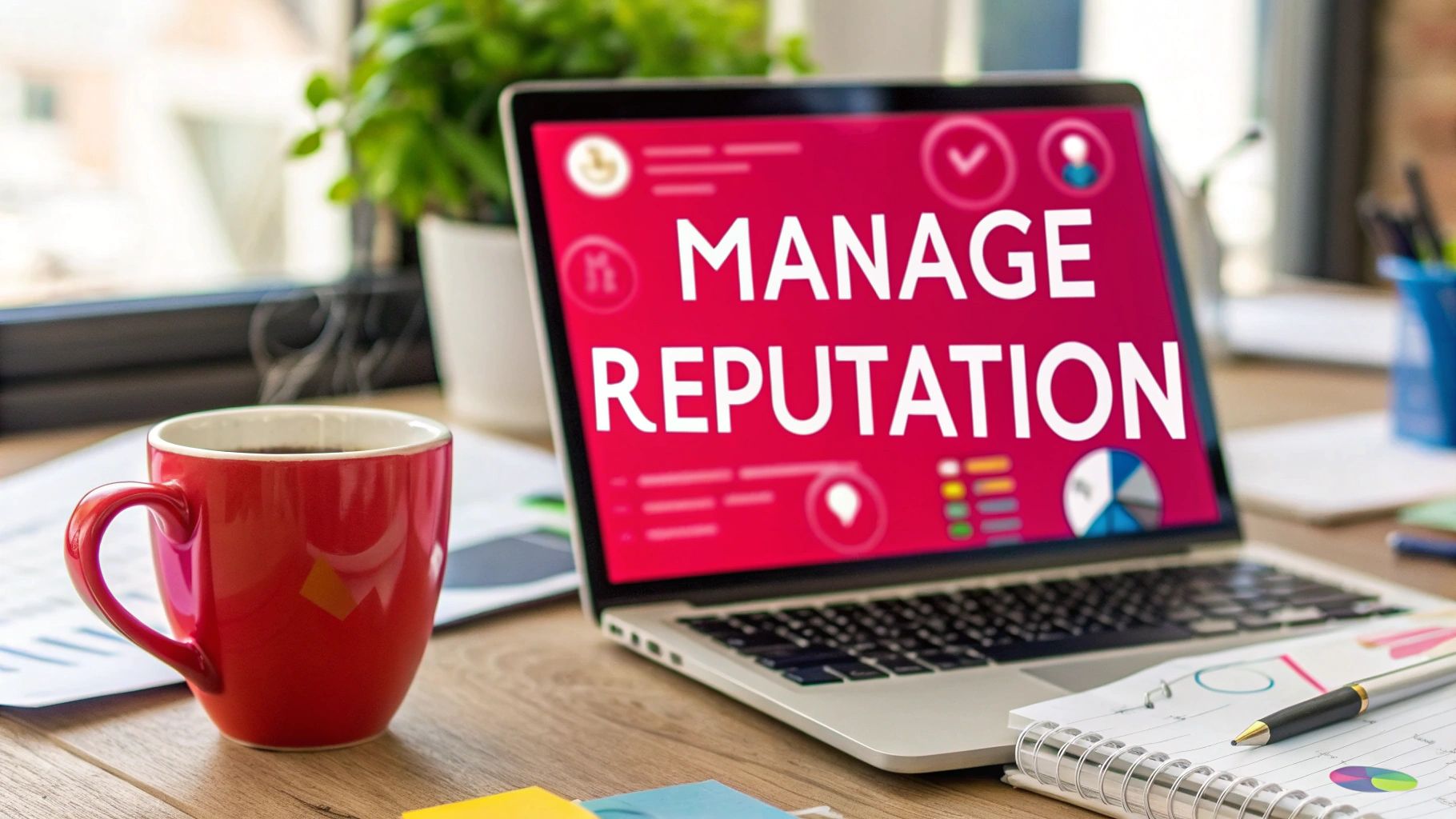Discovering What The Internet Really Says About You

Let's be honest, most of us don't really know what our online presence looks like. A quick Google search just doesn't cut it. A real digital audit is more like deep spring cleaning for your digital life. Trust me, you'll find stuff you forgot existed. Understanding how others see you online is the first step to taking control, and if you want to dive deeper into those strategies, check out this guide on managing online reputation.
Beyond The Basics: Unveiling Your Hidden Digital Footprint
Your digital footprint goes way beyond social media. Think old forum posts, blog comments, even ancient reviews on sites you've forgotten about. All of it adds up to the online "you." I once had a client who was mortified to find a negative comment they left on a niche forum years ago, sitting right there on page one of Google search results for their name. These are the hidden corners a good digital audit brings to light.
Also, think about location. For example, online reputation management in the Middle East and North Africa (MENA) region is a rapidly growing area. The 2025 MENA Barometer by Partoo highlights some fascinating trends in the region, showing just how crucial a strong online presence is for businesses there. This means knowing the local online landscape is key for effective reputation management, especially in a place like the AE region.
Free Tools, Real Insights
You don't need fancy, expensive software, at least not right away. Free tools like Google Alerts and the search functions built into social media platforms are surprisingly powerful. I've seen small business owners find some pretty shocking reviews on platforms they didn't even know they were listed on, just by using free tools. These early discoveries are a great way to start understanding the true scope of your online presence.
Before diving into the tools, it’s helpful to have a structured approach. Use the checklist below as a guide when reviewing your digital footprint.
| Platform Category | Key Elements to Check | Tools to Use | Priority Level |
|---|---|---|---|
| Search Engines (Google, Bing) | First page results for your name/brand, Autocomplete suggestions, News mentions | Google Alerts, Bing Webmaster Tools | High |
| Social Media (Facebook, Instagram, Twitter, LinkedIn) | Profile completeness & accuracy, Public posts & comments, Engagement levels, Follower demographics | Native platform search functions, Social listening tools | High |
| Review Sites (Yelp, TripAdvisor, Industry-specific platforms) | Ratings & reviews, Overall sentiment, Response to reviews | Yelp for Business Owners, TripAdvisor Management Center | Medium |
| Forums & Communities (Reddit, Quora, Niche forums) | Participation history, Sentiment of posts & comments, Relevance to your brand/industry | Native platform search | Medium |
| News & Media Outlets (Online newspapers, blogs, magazines) | Mentions of your name/brand, Tone of coverage, Author credibility | Google News, Media monitoring tools | Low (unless negative) |
This table provides a starting point. You can customize it based on your specific needs and industry. Remember, this is your digital life, so adapt the process to what matters most to you.
Prioritizing The Real Threats
Not every negative comment is a crisis. A random angry tweet matters a lot less than a bunch of bad reviews on a trusted site. A good digital audit helps you see the difference between real threats to your reputation and noise you can ignore. This way, you can focus your energy where it'll have the most impact. It sets you up for success, taking you from discovery to action.
Building Your Early Warning System That Actually Works

The infographic above gives you a visual snapshot of key metrics for managing your online reputation. It covers things like how often your brand is mentioned, the general sentiment (positive, negative, neutral), and how quickly you're responding to comments. Notice the upward trend in brand mentions over the past six months? That's coupled with mainly positive sentiment and a consistently quick response time. This tells us someone's doing a great job managing their online presence.
Let’s be honest, randomly checking Google is not a strategy; it’s a disaster waiting to happen. You need a system that catches issues before they escalate. I’ve personally seen businesses avoid absolute PR nightmares because their monitoring system flagged a negative mention within hours. That speed is invaluable.
Beyond Basic Search: Finding The Right Keywords
Don't just monitor your brand name. Think about variations, misspellings, and related terms. Let me give you an example. Imagine you own a restaurant in Dubai called "Spice Paradise." You’d obviously track "Spice Paradise," but you should also monitor "Spice Paradice" (common misspelling), "best Indian food Dubai" (relevant search), and even "Spice Paradise complaints" (potential issue). These broader searches paint a much more complete picture of the online conversation around your brand.
For a truly robust system, you'll want to consider platform-specific monitoring. Tools like Twitter Monitoring allow you to set up tailored alerts based on the nuances of each platform. While free tools like Google Alerts can be a good starting point, investing in a dedicated reputation monitoring tool is essential for comprehensive coverage.
Actionable Alerts, Not Noise
The goal isn't to be bombarded with every single mention; it's about getting useful information. Most monitoring tools allow you to filter alerts by sentiment, location, and source. This means you can fine-tune your notifications to only receive alerts for, say, negative mentions from influential blogs in your region.
This targeted approach is essential. Personally, I set up alerts for mentions on key review platforms like Yelp and TripAdvisor, relevant industry forums, and major news sites. This keeps me in the loop without drowning in irrelevant notifications. It's about quality insights, not quantity. This proactive approach is the bedrock of effective online reputation management.
Here’s a quick look at some of the more popular reputation monitoring tools out there:
To help you choose the right tools for your needs, I've put together a comparison table.
Reputation Monitoring Tools Comparison: Side-by-side comparison of popular reputation monitoring tools with features, pricing, and effectiveness ratings.
| Tool Name | Key Features | Pricing Range | Best For | Effectiveness Rating |
|---|---|---|---|---|
| Google Alerts | Basic mention tracking, email alerts | Free | Individuals, small businesses starting out | Good for basic monitoring, but limited features |
| Mention | Real-time monitoring, sentiment analysis, social media management | Varies depending on plan | Businesses of all sizes | Excellent for comprehensive monitoring and engagement |
| Brand24 | Social listening, influencer identification, reporting & analytics | Varies depending on plan | Medium to large businesses, agencies | Very good for in-depth analysis and influencer marketing |
| Awario | Boolean search, lead generation, competitor analysis | Varies depending on plan | Businesses focused on lead generation, competitor analysis | Great for identifying sales opportunities and competitive intelligence |
| Talkwalker Alerts | Free alternative to Google Alerts, customizable alerts | Free | Individuals, small businesses | Good for basic monitoring with more customization options |
As you can see, there's a range of options available, from free basic tools to more sophisticated paid platforms. The best choice for you will depend on your specific needs and budget. But trust me, having some kind of system in place is far better than none.
Creating Content That Builds Genuine Trust And Authority

Forget about trying to trick search engines with thin content. This is about smartly showcasing your expertise so that positive search results happen organically. Think of it like building a house on a solid foundation, not just slapping on a fresh coat of paint. This foundational approach is what delivers long-term success when you’re managing your online reputation.
The Psychology Of Trustworthy Content
People crave authenticity. They're looking for real value, not just marketing jargon. Think about your own online shopping habits. Do you only look at the product page? Or do you dig deeper – checking reviews, blog posts, and maybe even social media? Chances are, you’re looking for confirmation that the brand’s claims are true. This is why creating content that addresses genuine user needs and pain points is so important.
This desire for authenticity is even more pronounced in the AE region, where personal relationships and trust are paramount to doing business. In my experience, building genuine connections with clients and demonstrating real expertise produces far more impactful results than simply pushing sales messages. Authenticity is the cornerstone of effective online reputation management.
Content Formats That Enhance Reputation
Different formats achieve different things. Blog posts are excellent for in-depth knowledge sharing and positioning yourself as an expert. Videos can create personal connections and humanize your brand. Infographics can make complex information easy to understand and share. Even a well-written social media post can subtly boost your authority. The key is knowing your audience and picking the formats that resonate with them. If you're looking for guidance, you might find this resource helpful: creating a sound digital marketing strategy. It can help you shape your content creation efforts.
Case Studies: Content As A Reputation Transformer
I've seen clients completely overhaul their online presence through strategic content creation. For example, I worked with a tech startup in Dubai that was struggling with negative reviews about their customer service. Instead of getting defensive, they proactively created helpful tutorials and blog posts addressing common user issues. This not only helped existing customers, but it also positioned the company as a valuable resource. The result? More positive reviews and increased trust. This is especially important in the MENA region, where startup investments are booming. Just recently, 40 startups raised $282 million, which underlines the importance of careful online reputation management in this competitive landscape. You can find more about this here.
This shift in strategy highlights the power of using content not just for marketing, but as a central pillar of reputation management. By addressing real user needs and offering genuine value, you build credibility and establish long-term trust. It's a long game, but one that delivers significant returns over time.
Turning Angry Customers Into Your Biggest Advocates
Negative feedback is inevitable. It's not if it happens, but when. And when it happens, how you react can either escalate the situation or turn it into a win. I've personally seen how a well-crafted response can transform a furious customer into a loyal fan, and it's pretty amazing to witness.
It's like diffusing a bomb. You need the right tools and a calm approach. The payoff? A stronger relationship with your customer and a boost to your online reputation.
Understanding the Psychology of a Negative Review
When a customer leaves a negative review, they're not just complaining about a product or service. They're expressing a deeper frustration – a feeling of being unheard or undervalued. Responding effectively means addressing this emotional need. Think about it – haven't you ever been more upset by a company's dismissive response than the original problem itself? I know I have. Acknowledging their frustration and validating their feelings is the first step toward de-escalation.
It's like when a friend is venting. Sometimes they just need to be heard, and knowing someone understands makes all the difference.
The Art of the Empathetic Response
Responding with empathy isn't about admitting fault; it’s about showing you understand. Phrases like, "I understand how frustrating this must be," or "I can see why you're upset," can go a long way in diffusing a tense situation. Even if the customer is mistaken, acknowledging their perspective shows you care. This is especially important in a region like the AE, where building trust and rapport is crucial for strong customer relationships.
It's about building bridges, not walls. Even a simple acknowledgement can turn a negative interaction into a positive one.
From Damage Control to Reputation Enhancement
Responding to negative feedback isn't just about putting out fires; it's a chance to showcase your commitment to customer satisfaction. A thoughtful response can resolve the immediate issue and improve how your brand is perceived. I once saw a hotel in Abu Dhabi turn a scathing review about a booking error into a glowing testimonial. They apologized, offered a complimentary upgrade, and followed up personally. The customer was so impressed, they became a regular and started recommending the hotel to everyone.
This is the power of turning a negative into a positive. The e-commerce market in MENA, influenced by factors impacting online reputation management, highlights the importance of handling this well. Explore more about the MENA e-commerce market here.
Think of negative feedback as an opportunity. A chance to not just fix a problem, but to show everyone how much you value your customers.
Timing is Everything: When and How to Respond
Responding quickly is important, but don’t rush. Take a moment to consider the situation before you reply. A hasty, poorly worded response can do more harm than good. Aim to respond within 24-48 hours, sooner if the situation is urgent. Always respond publicly first, acknowledging the issue and offering to take the conversation offline for a private resolution. This shows transparency and assures other potential customers that you take feedback seriously.
It’s a balancing act. Respond quickly, but thoughtfully. Public acknowledgement, private resolution.
Knowing When to Disengage: The Art of Strategic Ignoring
Not every negative comment needs a response. Sometimes, ignoring inflammatory trolling or obvious spam is the best approach. Engaging with these comments can give them more visibility and unintentionally legitimize their claims. Focus your energy on addressing genuine concerns from real customers. This targeted approach is much more effective for managing your online reputation.
Pick your battles. Focus on genuine concerns, and don't get dragged into unproductive arguments. Sometimes, silence is golden.
Mastering Social Media Without Losing Your Authenticity

Social media…it's a beast. It can catapult you to success or destroy your reputation in the blink of an eye. Finding that sweet spot, the balance between engaging authentically and safeguarding your image? That's the real secret to online reputation management. For those interested in the UAE market, here are some resources specifically for social media marketing in the UAE.
Platform-Specific Strategies for Authentic Engagement
Let's be real, each platform has its own vibe. Instagram is your visual storyteller. Twitter? Quick, witty, and in the moment. Then there's LinkedIn, the suit-and-tie network where professional connections reign supreme. Knowing these nuances is crucial. You can't just copy-paste your message across all channels. It just won't land.
Imagine a local Dubai business. Sharing behind-the-scenes glimpses on Instagram, engaging in relevant Twitter conversations, and posting thought-provoking articles on LinkedIn? That’s how you build a multi-faceted, authentic presence. It’s so much more powerful than a generic, one-size-fits-all approach.
Social Media Policies: Preventing Disasters Without Stifling Connection
Social media policies often get a bad rap, like they're designed to turn us into robots. But honestly, they're just guardrails. They’re there to prevent disasters. I’ve seen it firsthand. I once worked with a company that faced a huge backlash after an employee posted an offensive tweet from the company account. A solid social media policy could have prevented the whole mess.
A good policy outlines what’s acceptable to post, how to handle customer questions, and who has access to accounts. It's about setting boundaries, not killing creativity. This is particularly important in the AE region, where a professional online image is paramount.
Navigating Controversy and Viral Situations
Controversy on social media? It's not a matter of if but when. Whether it's a trending hashtag, a viral moment, or a negative review, knowing how to react is essential. Ignoring it rarely works, but neither does jumping in guns blazing. I've witnessed companies handle controversy with grace by acknowledging concerns, addressing issues head-on, and taking the conversation offline when needed.
Want to know how well you’re turning those unhappy customers into brand advocates? Track your churn rate. This formula can help: Customer Retention Rate Formula. It’s especially valuable for businesses in the AE region, where fostering long-term client relationships is key.
Proactive Social Media for Reputation Enhancement
Don't just use social media to put out fires. Use it to build your reputation. Sharing valuable content, interacting with your audience, and showcasing your expertise positions you as an industry leader. You’re creating a strong foundation. So, when challenges do arise, you’re already seen as credible and trustworthy. This proactive approach turns social media from a reactive platform into a powerful tool for long-term reputation management.
Rebuilding After Your Reputation Takes A Major Hit
When a reputation crisis hits, it’s not just about putting out the fire. You have to rebuild, and that’s a whole different ball game. Think of it like recovering from a hurricane. You don't just slap a bandage on things; you reinforce everything to be ready for the next storm. This section is all about those critical rebuilding strategies. You might also find some helpful tips in these resources on web care strategies.
Legal Considerations: When to Call In The Experts
Sometimes, a reputation crisis is bigger than bad reviews and online gossip. It can involve legal stuff like defamation or copyright infringement. Knowing when to get a lawyer is critical. I've seen businesses try to handle legal issues on their own, and it almost always backfires. If you’re facing legal action, or even if you think you might be, talk to a lawyer right away. Don’t wait. A legal professional can guide you and protect your interests.
Advanced SEO Strategies: Suppressing Harmful Content
When negative stuff dominates search results, you need to push it down. This isn't about gaming the system; it’s about creating lots of positive, authoritative content that naturally ranks higher. This takes a smart content strategy that works with your long-term goals. Think about creating detailed blog posts, engaging videos, and informative infographics that showcase your expertise and address what people are worried about. Make sure this content is optimized for the right keywords and shared everywhere. The goal is to bury the negativity under a mountain of useful, positive information.
Communication Tactics: Demonstrating Genuine Accountability
Rebuilding trust isn’t just about saying sorry. It takes real accountability and showing you've changed. Be clear about what you’re doing to fix the problems that caused the crisis. Don’t just make promises; show action. For example, if customer service was the issue, explain how you’ve retrained your team and put new procedures in place. Being transparent like this builds credibility and shows you’re serious about doing better. It's like fixing a broken relationship. Saying the right words is important, but actually changing your behavior is what matters.
Case Studies: Learning From Recovery Stories
Looking at real-world recovery stories can give you great ideas about what works and what doesn't. Find examples of businesses or people who have rebuilt their reputations after a major mess. Look at what they did, how long it took, and what resources they used. These case studies are full of lessons you can use in your own situation. It’s like looking at a map before a road trip. It helps you navigate the road to recovery.
Measuring Progress: Tracking Your Recovery Journey
Rebuilding a reputation takes time and effort. It’s important to track your progress so you can see what’s working and what’s not. Keep an eye on key things like where your brand name shows up in search results, what people are saying about you online, and customer reviews. This information gives you valuable feedback and helps you tweak your strategy as you go. It’s like checking your vital signs when you're recovering from being sick. It helps you see how you're healing.
Avoiding Setbacks: Common Mistakes to Steer Clear Of
Some mistakes can really sabotage your recovery and set you back. For example, ignoring negative feedback, not fixing underlying issues, or making empty promises can make things worse. Learn from other people's mistakes and don’t do the same thing. It’s like learning from an experienced sailor about navigating dangerous waters. Their wisdom can keep you from crashing.
Your Long-Term Reputation Success Blueprint
Managing your online reputation isn't a one-off project; it’s a continuous journey. Think of it like looking after a prized plant – you need to regularly tend to it to ensure it flourishes. This section maps out how to maintain and improve your online reputation over the long haul. It's all about building genuine trust and credibility, not chasing those flashy quick fixes that can ultimately do more harm than good.
Integrating Reputation Management Into Your Daily Routine
Reputation management shouldn’t feel like another dreaded task on your to-do list. Weave it into your existing workflow. Just like you check your emails and scroll through social media, make checking your online presence a regular habit. For example, set aside 15-20 minutes each day to scan mentions, reply to comments, and track your progress. Trust me, this consistent effort stops small issues from turning into full-blown PR nightmares. It’s just like brushing your teeth – a small daily habit that prevents much bigger problems later.
Early Warning Signs: Spotting Trouble Before It Escalates
Think of it this way: just as a doctor monitors vital signs, you need to keep an eye on key indicators of your online health. A sudden dip in ratings, negative comments on influential platforms, or a spike in negative mentions – these are all red flags demanding immediate attention. Catching these early warning signs lets you address issues before they get out of hand. It’s like spotting a small leak in your roof – fix it early and you avoid a much costlier repair job down the line.
Metrics That Matter: Measuring Your Reputation Health
Vanity metrics like follower count don’t tell the full story. Instead, focus on metrics that actually reflect your reputation. Things like sentiment analysis (the overall positive or negative tone of online chatter about you), engagement rates (how actively people are interacting with your brand online), and customer reviews (what people are saying about your products or services) paint a far more accurate picture of your online standing. These are the true vital signs of your online health.
Building a Sustainable Reputation Strategy
Real reputation management isn’t about reacting to problems; it's about proactively building a positive online presence. Consistently creating valuable content, genuinely engaging with your audience, and showing a real commitment to customer satisfaction lays a solid foundation that can weather the occasional negative feedback. Think of it like investing in solid foundations for a building – it can withstand the occasional storm.
Ready to take your online presence to the next level? Grassroots Creative Agency can help you craft a tailored strategy that builds real trust and delivers tangible results. We offer everything from content creation and social media management to web design and reputation monitoring, providing a holistic approach to your online success. Let us help you cultivate a thriving online garden that blossoms with positive engagement and lasting credibility.








